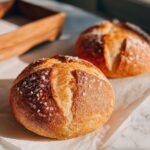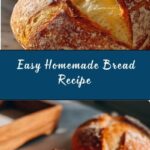Description
This homemade bread recipe produces a soft, golden loaf with a crispy crust using simple ingredients and a straightforward method. Perfect for beginners, it involves activating yeast, kneading dough, allowing it to rise, shaping, and baking to create fresh, delicious bread ideal for sandwiches or toasting.
Ingredients
Scale
Dry Ingredients
- 4 cups all-purpose flour (can substitute some with whole wheat flour)
- 1 packet (2 ¼ teaspoons) active dry yeast
- 2 tablespoons sugar
- 1 tablespoon salt
Wet Ingredients
- 1 ½ cups warm water (about 110°F/43°C)
- 2 tablespoons olive oil (or melted butter)
Instructions
- Activate the Yeast: In a small bowl, dissolve the sugar in warm water. Sprinkle the yeast on top and let it sit for 5-10 minutes until it becomes frothy, which indicates the yeast is active and ready to use.
- Make the Dough: In a large mixing bowl, combine the flour and salt. Add the frothy yeast mixture and olive oil or melted butter. Stir until a sticky dough forms, then transfer to a floured surface and knead for 8-10 minutes until the dough becomes smooth, elastic, and slightly tacky.
- Let the Dough Rise: Lightly grease a large bowl and place the kneaded dough inside. Cover it with a clean towel and allow it to rise in a warm spot for 1 to 1.5 hours, or until it doubles in size. This proofing period develops the bread’s texture and flavor.
- Shape the Dough: Punch down the risen dough to release built-up gas. Shape it into a loaf shape and place it in a greased loaf pan. Cover again and let it rise for another 30-45 minutes until it is puffed and nearly doubled.
- Bake the Bread: Preheat your oven to 375°F (190°C). Bake the loaf for 30 to 35 minutes until the top is golden brown and the loaf sounds hollow when tapped, indicating it is fully baked through.
- Cool and Serve: Allow the bread to cool in the pan for a few minutes, then transfer it to a wire rack to cool completely before slicing. This prevents the bread from becoming soggy and maintains its perfect texture.
Notes
- You can substitute part of the all-purpose flour with whole wheat flour for a heartier bread.
- Ensure the water is not too hot when activating the yeast to avoid killing the yeast.
- Kneading time is crucial to develop gluten for optimal texture.
- Use a clean kitchen towel or plastic wrap to cover dough during rises to prevent drying out.
- Check for doneness by tapping the bottom of the loaf—it should sound hollow.
- Allow the bread to cool completely before slicing to avoid a gummy crumb.

